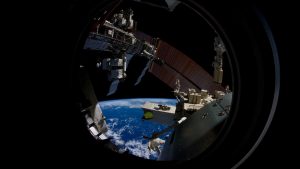Screen Innovations – THE FIRST SCREEN INTO SPACE
The National Aeronautics and Space Administration (NASA) recently asked Screen Innovations (SI) to do something that no other projection-screen company has done: put the first projection screen in space! Yes, you read that correctly. SI has developed a one-of-a-kind, ambient-light–rejecting, zero-gravity screen that is about to be installed in the International Space Station, to be used every day by astronauts and cosmonauts.
On March 27, 2015, one astronaut and one cosmonaut traveled to the International Space Station (ISS), where they will remain for a year while a team back on Earth studies the effects on them of long-term spaceflight. Because the astronaut is one of a pair of identical twins, this study will offer scientists a unique opportunity to establish a control, to achieve a far more accurate study of the effects of zero gravity on the human body.
Before installation of SI’s screen, the only form of communication available to astronauts on the ISS was via tablet-sized, 13-inch displays. As you can well imagine, the larger screen will allow crewmembers to experience images of their families that are closer to life-size, and to feel as if their loved ones are there with them in the cabin. Along with video chatting, the crew had also used small laptop computers for training and simulated operation of the ISS’s robotic arm. Obviously, the benefits of using these types of applications on a much larger screen are, literally, huge.
SI has always enjoyed a fun-loving company culture dedicated to constant innovation in screen technology and to pushing—and sometimes completely removing—the boundaries of two-piece projection. This made working with NASA a logical fit. Since its founding, in 1958, NASA has been devoted to innovation, and to pioneering the age of space travel and exploration. It’s safe to say that SI has once again gone where no other screen company has gone before.
WHERE DO YOU EVEN START?
In their eight months of work on the ISS project, the SI engineering team faced nonstop challenges, such as how to unroll and set up the screen as quickly as possible in zero gravity, and the fact that, in the ISS, the lights are always on—unlike a standard matte-white screen, SI’s screen material had to be able to preserve the projector’s contrast ratios. These challenges tested the team’s ability to deliver on a longtime SI motto: to provide “two-piece projection in any environment.” Ryan Gustafson, CEO of SI, said, “Space – it’s the ultimate environment. If we can put a screen there, we can put a screen anywhere on Earth.”
First, the ISS screen had to be constructed in such a way that it would be portable, and could be unrolled and made ready for viewing in seconds, in any module of the ISS. The screen also had to be easily packed away on the ISS – a permanently installed screen was not an option. “Fixed is easy, but a portable setup brings all sorts of challenges to the table,” said Tom Nugent, Technology Specialist at SI. Not only did the screen have to be portable, it had to be extremely portable. The final dimensions of the screen, when packed, could be no larger than those of a standard mailing tube for blueprints: roughly 3 feet long, with a diameter of 2½ inches. This immediately eliminated some screen materials – such as SI’s Black Diamond® and FlexGlass®, which can’t be tightly rolled – and left only a few remaining options.
For full details visit http://www.screeninnovations.com/commercial-zero-gravity/iss-viewscreen/

